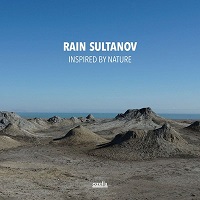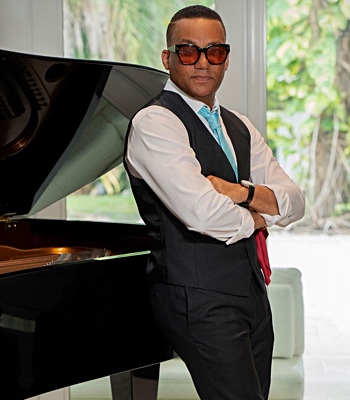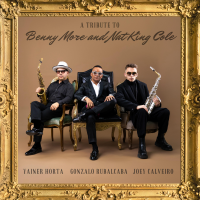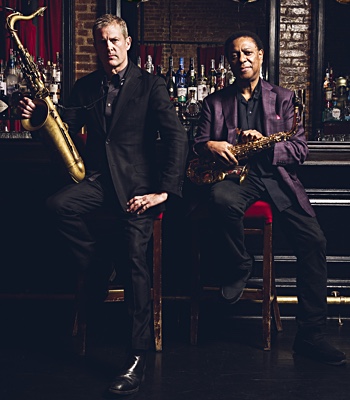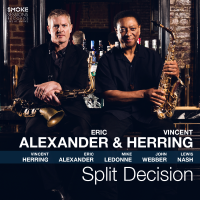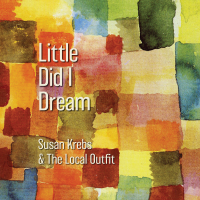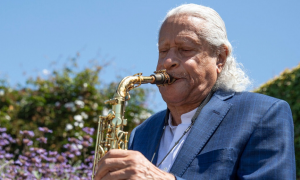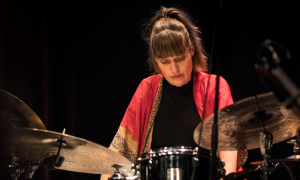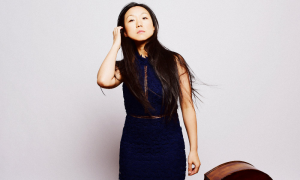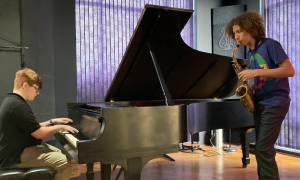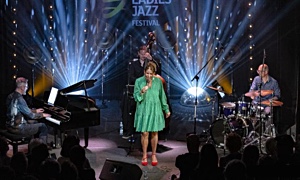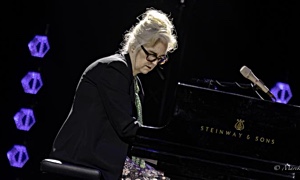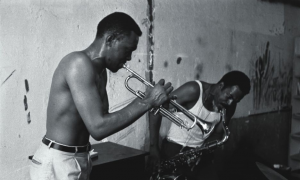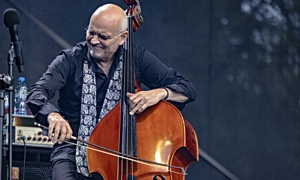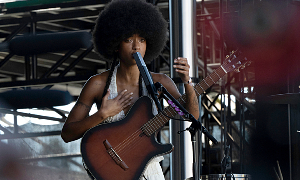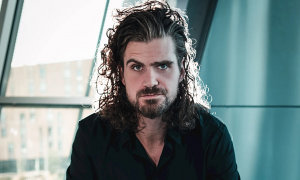Home » Jazz Articles » Interview » Charles Lloyd: The Winds Of Grace
Charles Lloyd: The Winds Of Grace
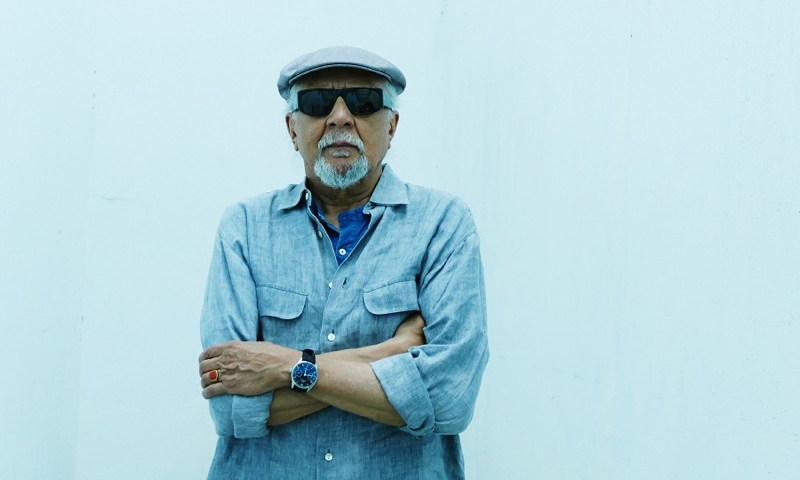
I give all I can each night because it could be the last night. I just leave it all out there every night no matter where I’m playing.
—Charles Lloyd
The latter formation's baptism came with the acclaimed I Long to See You (Blue Note, 2016), and the good news is that another studio album from his latest ensemble is currently in the pipeline.
More immediate cause for celebration, however, is the release of Passin' Thru (Blue Note, 2017), a recording that captures Lloyd's New Quartet of Rogers, Harland and Jason Moran in its element at the 50th Montreux Jazz Festival in 2016, and at The Lensic in Santa Fe, New Mexico a month later.
Passin' Thru marks the tenth anniversary of Lloyd's New Quartet, which first came together in April 2007. The live album Rabo de Nube (2008)—named after Cuban singer-songwriter Silvio Rodriguez's tune—was a fine introductory calling card. That was followed by Mirror (2010) and Athens Concert (2011), the stunning collaboration with Greek singer Maria Farantouri, lyra player Socratis Sinopoulos and pianist Takis Fariz, recorded live at the Herodes Atticus Odeon—all on the ECM label.
Then, after a near twenty-five year association with Manfred Eicher's ECM label, Lloyd—not for the first time in his career—threw something of a curveball, by singing with Blue Note Records. It marked a return to the famous label for whom Lloyd had released one live album in the mid-1980s.
Lloyd's departure from ECM, with whom he'd recorded sixteen albums since 1989—a major legacy—was clearly a significant career decision and not one lightly taken. The details of the rupture are personal, though Lloyd states simply: "I have love and respect for Manfred, and I am sure he has love and respect for me..."
Lloyd's first release after resigning with Blue Note was the suite Wild Man Dance (Blue Note, 2015), described by Allmusic's Thom Jurek as "truly inspirational."
Jurkek's assessment was closer to the truth than he perhaps imagined. Wild Man Dance was the fruit of a commission by Jazztopad, the internationally renowned festival in Wroclaw, Poland. Festival director Piotr Turkiewicz had spent a couple of years serenading Lloyd and encouraging him to write completely new music especially for Jazztopad 2013.
Lloyd had over a year to compose the music, but inspiration is not something that can be switched on and off like a tap, as Lloyd explains: "I was working slow on that Wild Man Dance and then about three weeks before we left for Poland all this music just started abundantly pouring out of me. I'm hiking in the mountains, I'm swimming in the water and all this music starts flooding out. As we were even leaving I was still writing music and some of the movements didn't make it there."
A year and a half after the world premiere of Wild Man Dance at Jazztopad, and just a week after the album's Blue Note release, Lloyd received the National Endowment of the Arts Jazz Master award, in recognition of his outstanding contribution to jazz since the mid-1950s.
Although the continual adulation of audiences world-wide throughout the years is arguably the greatest barometer of Lloyd's ongoing success, he is, nevertheless, grateful for the official recognition. "It's great," says Lloyd. "It's nice to be honoured and appreciated."
Other significant awards have come in what appears to be a golden period in Lloyd's career. In 2015, Berklee College of Music awarded Lloyd an honorary Doctorate. Of greater personal note, however, was when Lloyd returned to his hometown of Memphis in 2012 to receive a note on the Beale Street Brass Note Walk of Fame. The corresponding concert that Lloyd gave was his first in his hometown of Memphis since 1964.
Lloyd's long aversion to playing in the town he grew up in had been the result of the racism he encountered belonging to a mixed-race family in the racially conflictive environment that prevailed in the Memphis of the 1930s and 1940s.
After the guts of half a century, to play Memphis again, where he cut his teeth playing with Howlin' Wolf, B.B. King, Johnny Ace and Bobby Blue Bland, has been a cathartic experience for Lloyd. "If a general conquers a thousand men a thousand times and one man conquers himself, who's the greater? I'm of that school," says Lloyd.
Lloyd is more expansive on the difficulties and prejudices of those times growing up in Memphis in Joseph Woodard's Lloyd biography A Wild, Blatant Truth (Silman-James Press, 2016). With touring and a new recording to promote, Lloyd, naturally enough, is keener to talk about his music.
Whilst Lloyd has always been open to new collaborations, his groups of the past decade and more have been remarkably stable. "I like the simpatico of a cohesive unit," explains Lloyd. Drummer Eric Harland has been the bedrock of Lloyd's groups since late 2001. Harland was stepping into the shoes of Billy Higgins, who died in May that year.
As Lloyd explains, Higgins was a little bit special. "You were always trying to get another breath to keep playing because Higgins made you feel so good. He could play behind the beat, in front of the beat—he could make you a tailor-made suit. He was very special."
Higgins' were mighty big shoes to fill but Lloyd feels that Harland's arrival was fated. "When Master Higgins left in May 2001, on his deathbed he said 'Let's keep working on this music. I'm not going to be there but I'll always be with you.' Then a few months later I meet Eric."
It was around the time of 9/11. Lloyd was playing at the Blue Note. He came downstairs at the end of the evening and caught the jam band, whose drummer, the twenty-five-year old Harland, caught Lloyd's attention. "He had this radiance," says Lloyd. "I knew Higgins had sent him."
Harland joined Lloyd shortly thereafter and has remained ever since. In addition, Harland has played with the likes of Dave Holland, McCoy Tyner, Kurt Rosenwinkel, Terrence Blanchard, Joshua Redman and the SF Jazz Collective, earning a reputation as one of standout jazz drummers of his generation.
Then, in 2003, Lloyd was invited by John McLaughlin to attend a Shakti concert. Lloyd met Zakir Hussain, planting the seeds of Sangam, with Harland rounding out the trio. To date the trio has cut just the one CD, the spectacular Sangam (ECM, 2006), which captured a live performance in Santa Barbara California, 2004. "That was magic chemistry," purrs Lloyd.
Sangam may be a little studio shy, but the trio continues to perform live around the world, albeit infrequently due to everybody's busy schedules. "It's ongoing," affirms Lloyd.
Lloyd's main band in this period, however, has been his quartet. Pianist Jason Moran, like Harland, has formed a particularly close musical understanding with Lloyd, a simpatico that shone on their duo recording Hagar's Song (ECM, 2013). Moran and Harland's own projects, however, have become ever-more time consuming, and in fact, the 2016 tour that produced Passin' Thru marked the first extended tour of Lloyd's New Quartet in several years.
Inevitably, a new pianist and drummer entered the narrative—Utrecht-born, Los Angeles-reared, Gerald Clayton and drummer Kendrick Scott. Refitting half the quartet may seem like a serious challenge, but Lloyd embraces the coming and going of musicians in his quartet. "The transition is always gentle," says Lloyd.
"Kendrick and Eric are from the same town—Houston. They grew up together, they're very close," says Lloyd. "Eric is very fond of Kendrick and has been wanting me to play with him. So, Kendrick would come around to a lot of our gigs. It was an easy transition because Eric had prepared him. He had done his homework."
Clayton's story is not dissimilar. "He used to come around and hear the quartet and I would always see him backstage," Lloyd recounts. "Jason had so many commitments he couldn't come, so Reuben recommended I try Gerald and it worked out well. The music is not set. It evolves and it flows and I have to have musicians who can take the journey with me and who have wide palettes. I take it as a blessing, rather than an arduous task. I've been blessed like that all my life. The guys come and they want to be here."
Another group of musicians whose dream of playing with Lloyd was realized in November 2016 was the acclaimed Polish trio of Marcin Wasilewski, Slawomir Kurkiewicz and Michal Miskiewicz, who came to wider international prominence in the 2000s with Tomasz Stańko.
"It was great," recalls Lloyd of the one-off concert in Roma Theatre, Warsaw. The seeds of the collaboration had been planted over a decade before, when Lloyd and Stanko's group had shared billing on a number of concerts in San Francisco, New York and London.
"I said backstage once it would be nice to play with these guys because they had a musicality that was interesting," Lloyd recalls. "I planted a seed in them and they were all hot to do it. So their management and Dorothy [Darr, Lloyd's partner and manager] were talking back and forth and they found a hole in my schedule and they tried to plug it up."
The four musicians only had one rehearsal prior to the concert but the Polish trio had clearly done their homework. "Again, they were prepared. They had studied my music," says Lloyd. "I also brought along a lot of new music and they absorbed it, and some of my old stuff. They particularly wanted to play "When Miss Jessye Sings," that I had recorded with Brad Mehldau. It was a beautiful concert," Lloyd enthuses. "We had a magical evening in Warsaw. It's like language and family."
A more enduring musical venture has been The Marvels, Lloyd's group with Bill Frisell, Greg Leisz, Rogers and Harland. Frisell has played with a staggeringly diverse range of people during his forty-year career, so it was perhaps surprising that his and Lloyd's stars had never crossed before.
"We had played some concerts decades earlier where we shared the bill," recalls Lloyd. "I remember one specifically in that church in Leipzig [St. Thomas Church] where Bach did all the music. But it was like two worlds, we didn't really interact. We didn't have deep contact. I realize now that he was shy."
It was Frisell, however, who made contact with Lloyd years later. "Then it started happening somehow. I think Bill reached out when Paul Motian left. He maybe asked me for a quote -they were going to do a concert in homage to Paul. I couldn't be there. Paul used to play with me also; that was the early period when Jack [DeJohnette] had gone with Miles [Davis]."
Frisell confided to Lloyd that he had been a big fan from an early age. "He said it started when he was thirteen and he was living in Denver and my group then was Keith Jarrett, Jack DeJohnette and Cecil McBee," Lloyd relates. "This is how Bill tells it—he realized that 'Oh, it can be like this.' It expanded his vision of possibilities so he was very inspired by that group, as a lot of people had been. He grew up with that aesthetic."
"Bill and I had this simpatico," continues Lloyd. "He's just a pure, incredible soul. He has this musicality. He's very quiet and he doesn't say a lot. We're like these troubadours, we sing these songs and they live in the air, they live in people's hearts and I hope they change the molecules in the air wherever we are and there won't be all this rape and pillage that keeps going on."
Lloyd relates an episode by way of illustration of the connection he and Frisell share. "One night I was playing a duo concert with Bill north of San Francisco in a beautiful town called Healdsburg, and after the concert we were taking a bow and I grabbed his arm. I held his arm. Afterwards I said: 'Do you know what was happening in that moment?' He said 'Yeah!' I said, 'It was like that movie with Sidney Poitier and Tony Curtis. Man, we were The Defiant Ones. We were standing up there. We were representing.' He said 'Yeah!'
"Then he went back to his hotel and at about two o'clock in the morning The Defiant Ones came on his television, so he sent us a photo of this black arm and this white arm reaching out for each other to get on the train," Lloyd laughs. "We have a lot of crazy synchronicities that go on. He is very poetic and all of our stuff is very poetic, every day."
Initially, Lloyd's concept for The Marvels was as a quartet with Rogers and Harland, but Frisell maybe had a broader vision. "Bill kept telling me about Greg Leisz. I didn't know Greg's music," admits Lloyd. "Then I had a concert at UCLA with Bill and he said 'It would be nice if we tried Greg, you know?' So, I invited him and Bill brought him along and showed him some of the music and it was beautiful."
The addition of Leisz on pedal steel guitar, in a way, was a return to old stomping grounds for Lloyd. "When I was a kid in Memphis there was a pedal steel player, Al Vescovo, who was a great musician," remembers Lloyd. "He and I as teenagers would get together and jam and explore. He was a white boy and racism didn't let us cross-pollinate our groups, so we would have to play in private to jam and stuff like that. I had this simpatico with Al Vescovo."
The Marvels now complete, the musicians entered the studio with the resultant debut I Long to See You (Blue Note, 2016) garnering a raft of positive reviews from the international press. In addition to re-workings of older Lloyd material, guest singers Willie Nelson, on the anti-war song "Last Night I Had the Strangest Dream," and Norah Jones, on "You Are So Beautiful," brought an added dimension to the music.
Nelson, the veteran singer of outlaw country music, might have seemed like a left-field choice, but Lloyd's appreciation of the singer's craft goes back decades. "When I was in exile in Big Sur Willie Nelson made that record, Stardust (Columbia, 1978) where he sings those standards. His tone touched me a lot," recounts Lloyd.
Lloyd's period of exile—when he effectively walked away from the music business—lasted the entire decade of the 1970s. It has cast a shadow of mystique over Lloyd that lingers to this day.
"I went away at a time when I was at the top of the game. But I had to go to heal myself. I was self-medicating and stuff like this, as a lot of us did," says Lloyd of the excesses of the 1960s. "I had to heal because I'd had signs that that wasn't the way for me."
In Big Sur, Lloyd sought spiritual regeneration, with Darr his constant companion. "We were very deep ascetics at that time. Every day I was fasting. I was listening to Bach's unaccompanied cello suites every morning -[Pau] Casals or János Starker. That was my morning music. After I'd mediate and go for hikes up in the mountains. We had a glorious life there. Our nearest neighbour was a mile and half on either side and we had all the mountains and the sea. We were very blessed. It gave me time to pull the arrow back and recharge the battery," says Lloyd of those years.
"You have to go inside and find your quiet centre to radiate from and then from that deep quiet you can go into action. My thing is meditation and a spiritual life. It always informs me, enhances me and gives me the strength to go forward in the music, so I just rededicated myself to the music."
Lloyd's rededication to the music from the 1980s onwards has been well documented, not least on all those ECM albums, and latterly, his releases on Blue Note. From Michel Petrucciani and Bobo Stenson to Brad Mehldau, from Geri Allen, Billy Higgins and John Abercrombie to Maria Farantouri and Bill Frisell. And from Willie Nelson to Norah Jones.
It was Lloyd's wife and manager, Dorothy Darr, who introduced Lloyd to Norah Jones's music. "I knew her father, Ravi Shankar," recalls Lloyd. "Something resonated with me about the simple directness of her sound. That Joe Cocker guy had been a neighbour of mine in Santa Barbara and I wanted to record "You Are So Beautiful"—that's a Billy Preston song—and I heard her voice purring in my ears," says Lloyd of Jones.
"When it [I Long to See You] was finally getting mixed we were out in Baku in Azerbaijan, in this big, modern hotel, and we were looking out at the sea from our hotel and we put Willie on singing. It was so moving. Those were two people that answered the call. It was beautiful."
From California to Azerbaijan, it seems there's nowhere in the world that Lloyd's music hasn't made an impact, affecting the molecules in a positive way. "Recently we played in Taipei in their big, national theatre, a beautiful, old elegant thing," Lloyd relates. "We played "Nu Blues" and I recorded it with [Billy] Higgins as "Windy Mountain." The kids in Taipei said 'That's "Windy Mountain"!' They knew it from Which Way Is East! [ECM, 2004] Ain't that deep!"
These days it's rare to see Lloyd in any other setting than a large concert hall. "I rarely play clubs because people are there for different reasons, the club is trying to sell beer or whatever they're doing. When I was a young man I played all these clubs and I didn't smoke, except the herb, but the atmosphere was always so smoky. My hair would be smoky, my clothes would be smoky."
The venue situation started to change in the mid-sixties. In 1964 Lloyd came to London with the Cannonball Adderley Sextet. The band, which also featured Nat Adderley, Louis Hayes, Sam Jones and Joe Zawinul, played the Royal Albert Hall and was also recorded in another concert by the BBC, footage of which can be found on Youtube. A couple of years later, following the release of Dream Weaver (Atlantic, 1966), Lloyd was back in Europe leading his own groups.
"When I started coming over with my group we played these wonderful halls with these wonderful pianos and I didn't want to go back into the saloons. I just didn't," Lloyd emphasizes. "I mean, I love the Village Vanguard and as a matter of fact I played there with Jason [Moran] a couple of years ago -the first time for forty or fifty years."
Another exception is the Dakota club in Minneapolis. "It's run by a man who's a serious music lover and we play there once a year," says Lloyd.
"Playing Carnegie Hall or the main concert hall in the Allen Room of the Lincoln Centre, or The Herodian, well that thing's five thousand years old. That's gotta knock your socks off!" exclaims Lloyd. "Something like that is really impressive and it touches your heart to have an invitation there.
"I love beauty, architecture and space so it's always a blessing when you get invited to some special place. But you never can know what the evening will be like. I give all I can each night because it could be the last night. I just leave it all out there every night no matter where I'm playing."
The year 1966 was a pivotal year for Lloyd. "I got blessed," he states simply.
That year Lloyd's group played the Monterey Jazz Festival, a performance that spawned the million-selling Forest Flower (Atlantic, 1967). Later that week, Lloyd took his group to a club in San Francisco's North Beach called El Matador. Just up the street on Broadway there was the improvisational theatre group called The Committee. "They'd come every night after their show would close and they would come to hear us. They didn't know anything about jazz but they just loved us," recalls Lloyd.
The Committee artists told Lloyd about a venue called the Fillmore, where Muddy Waters would play. "Muddy Waters? That's McKinley Morganfield. I love him, that's cool," says Lloyd, reminiscing. The Committee spoke to the Fillmore's owner Bill Graham, who invited Lloyd over to play for half an hour one Sunday afternoon.
"So, we went over and played and they wouldn't let us off the stage for an hour and a half. Santana always tells me he was down front screaming 'Free the people, Charles! Free the people!," Lloyd says laughing.
Graham, like the Fillmore crowds, loved Lloyd's group and began booking them on a more regular basis. "So, magic happens," says Lloyd. "I get off the chitlin' circuit of the clubs and other doors opened for me. I played the Filmore a lot and over at the Avalon Ball Room. Janis Joplin would always want us to be on the same bills as Jimi Hendrix and he and I would play together. We were planning to record but time ran out. I've been at a lot of intersections."
The music that Lloyd and Hendrix would have cooked up together can only be guessed at, but Hendrix wasn't the only fish that got away. Shortly after Lloyd had moved to New York at the beginning of the 1960s—another major intersection—he got a call from Thelonious Monk's manager.
"He wanted me to go up to Monk's house because Monk wanted me to play with him," Lloyd recounts. "I was like twenty two. I said, 'I'd love to so when Monk calls me I'm there.' He said, 'No, you just go up there.' I was too scared, you know, just go and knock on Monk's door! "
Lloyd never knocked and Monk never called. "That was one of the big laments of my life," Lloyd bemoans, "because he was one of the great architects of this music."
Seventy years after first picking up a saxophone Lloyd is rightly also considered, alongside Wayne Shorter and Sonny Rollins, as one of the music's great architects, a searcher of sounds.
"I've always been a sound seeker and this amazing thing happens that the sound keeps getting better and I think it has to do with character now. So as my character strips down, and I'm out of the way and I'm in service, the sound gets to that Prez kind of place. Prez's sound really touched me. It was one of the most beautiful I've ever heard," says Lloyd in reference to Lester Young, one of his earliest idols.
"I've been around long enough now that the sound I'm hearing in my mind's ear, I'm getting closer to it. But the Creator has a carrot on a stick thing with me and he says 'Not yet Charles.' But to be a part of this tradition is very rich and very wonderful."
In spite of the fame and relative fortune, the official recognition and global adulation that he enjoys, Lloyd remains, at seventy nine years of age, a most humble musician and human being.
"I'm in service," he says. "It's not my music, it's coming through me and I have to keep honouring that service. It's just another chance to tell the truth each time. It's a blessing for me to still be here and have such love for the music. As I said in Dororthy's film [ Arrows into Infinity, 2014] the winds of grace are always blowing and we must set our sails high. I'm always of that school to set my sails high. It's incumbent upon each of us to continue to sing the song and to go forward."
Lloyd continues to sing the song and to hoist his sails high, night after night. "I come with humility and I'm always nervous before I start," he concedes. "Then once I start I get met and then Dorothy is trying to get me off the stage. I don't know where the time went. Two hours later. What happened?"
What happened? The winds of grace caught Lloyd's sails.
Photo Credit: Courtesy of Dorothy Darr
Tags
Comments
PREVIOUS / NEXT
Charles Lloyd Concerts
Support All About Jazz
 All About Jazz has been a pillar of jazz since 1995, championing it as an art form and, more importantly, supporting the musicians who make it. Our enduring commitment has made "AAJ" one of the most culturally important websites of its kind, read by hundreds of thousands of fans, musicians and industry figures every month.
All About Jazz has been a pillar of jazz since 1995, championing it as an art form and, more importantly, supporting the musicians who make it. Our enduring commitment has made "AAJ" one of the most culturally important websites of its kind, read by hundreds of thousands of fans, musicians and industry figures every month.




